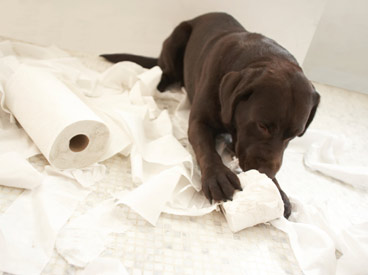Shredded tissues. Destroyed shoes. A gnawed coffee table. These are just a few of the things I have come home to after leaving my puppy unattended. Similarly many cat owners discover that their couch or curtains have been shredded by sharp claws. A hassle for you and a potential danger for your pet, chewing and scratching are behaviors that should be addressed.
Dr. Kelly Ballantyne, a veterinarian at the University of Illinois Chicago Center for Veterinary Medicine, says that chewing for dogs and scratching for cats are behaviors that we should expect from our four-legged friends.
“These behaviors should not be discouraged but directed to appropriate objects,” she says. Starting when your pet is young, you need to supervise your pet so that you can direct him to chew or scratch the appropriate items. For puppies and adult dogs, you can do this by providing them with chewable toys. If you are not able to supervise your dog, Dr. Ballantyne recommends confining him to a crate or pen with chew toys to prevent the destruction of household items. The chew toys should be durable, to prevent your dog from biting pieces off that could be swallowed, leading to potential intestinal issues. Strong, rubber toys with depressions or cavities in which you can place food or treats can also help to encourage your dog to chew on those items specifically.
For kittens and cats, you should provide scratching posts in multiple locations to encourage scratching of those items rather than your furniture. Any given cat may differ on its scratching preferences, so Dr. Ballantyne advises that you try various set-ups to determine what your cat prefers. You can place a post vertically or horizontally and in several locations of the house. The key is that the material of the post be shreddable, because cats use their scratching as a means of visual communication.
“Cardboard scratching posts are inexpensive and typically well-liked,” Dr. Ballantyne recommends. “You can also attach toys to the post, or place catnip around the post, to encourage investigation and scratching.”
Many pet owners have trouble directing these behaviors to the appropriate outlets. Until your pet can be trusted on its own, confinement to a crate or small “pet-proofed” room can save you a lot in the way of destroyed objects. Dr. Ballantyne says that such confinement can prevent reinforcement of the inappropriate behavior, and will likely allow your pet more freedom as an adult.
When pets continue to chew or scratch inappropriate objects, you should consider what you are providing them with as an outlet and how you are presenting it. For example, if you give an old shoe to a dog to chew on, he will learn that chewing on shoes is okay and may also chew on your brand new pair. Only items that are specifically for chewing should be provided.
If your cat continues to scratch a piece of furniture despite access to scratching posts, you can also place the post directly in front of the location where the cat has been scratching. Then the cat will be more likely to scratch the post than the piece of furniture. If your cat seems to have an affinity for a particular material, you can cover a scratching post with a similar material to encourage the scratching in a more appropriate location.
You may also need to take a look at your pet’s personality overall. Some pets may be overly destructive for other reasons. If the destruction takes place primarily when you are away from the home, your pet may have separation anxiety. Puppies and kittens (as well as high-energy adult animals) can also be more likely to chew or scratch destructively if they don’t have appropriate outlets for their energy. Increasing the amount of exercise and mental stimulation your pet gets daily may also help in preventing such destructive behaviors.
In the long run, the effort to train your pet and to provide him with appropriate chewing, scratching, and energy outlets could save you a lot of heartache and money related to destroyed household items and emergency veterinary bills.
For further information on appropriate chewing and scratching, please contact your local veterinarian.
Julia Disney is an Information Specialist at University of Illinois’ College of Veterinary Medicine.
Become a Saturday Evening Post member and enjoy unlimited access. Subscribe now



